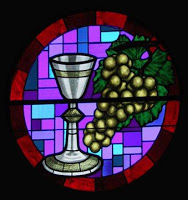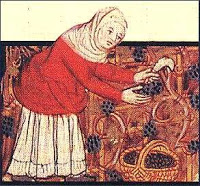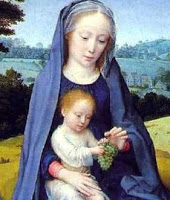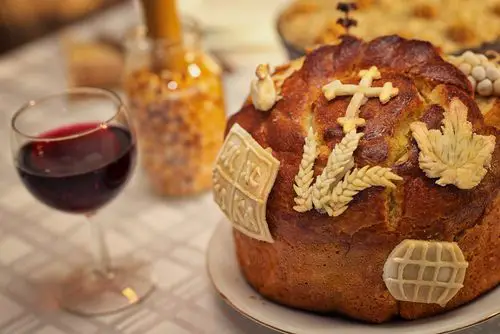An article by Reuters caught my interest today – lovers can officially ignore Valentine’s Day in
 Bulgaria because the day is given over to the celebration of wine and St. Trifon The Pruner. Wine makers across Bulgaria salute St. Trifon with the annual trimming of the grape vines, which symbolizes the end of winter. The tradition requires women to bake bread and roast hens in preparation for a post-pruning feast.
Bulgaria because the day is given over to the celebration of wine and St. Trifon The Pruner. Wine makers across Bulgaria salute St. Trifon with the annual trimming of the grape vines, which symbolizes the end of winter. The tradition requires women to bake bread and roast hens in preparation for a post-pruning feast.
In every town, the man deemed to have grown the most grapes that year is crowned King, put on a horse-cart, driven from house to house and ordered to get drunk with his friends in order to ensure a plentiful harvest in the coming year.
St. Trifon lived in the third century AD and is believed to have had the divine power to heal any sickness. He was tortured to death and beheaded for his Christian faith. The wine rituals have their roots in the devotion to the ancient Greek god of Dionysus and the Thracians who once inhabited the territory of modern Bulgaria and were known for their wine making skills.
St Vincent is the most well known Patron Saint of Wine Makers, Vine Dressers and
Vinegar Makers. He is also known as Vincent of Saragossa or Vincent of Aragon. Saint Vincent served as a Deacon to Saint Valerius in Spain and was imprisoned, tortured and martyred c 304 in Valencia for refusing to burn his sacred texts during the persecutions of Diocletian. He is remembered on 22nd January.
There are other saints who are hailed as Patron Saints of Wine Making:
St Amand of France is the Patron Saint of Brewers, Vintners, Inn Keepers and Bar Staff. He became a monk at the young age of 20 and lived as a hermit. His family tried to kidnap him to bring him home for “deprogramming” but failed. He was promoted to the Bishop of Maastricht and preached in France, Flanders, Gascony, Carinthia and Germany – often getting beaten for his trouble, His association with brewers and vintners comes from spending so much time preaching and teaching in beer and wine making regions. He died c584 at Poitou and is remembered on 6th February.
 Saint Goar of Aquitaine is the Patron Saint of Vine Growers and Hotel Keepers. Saint Goar was a priest who became a hermit at Oberwesel on the Rhein. He was well known for his sanctity, prophecies and miracles. Charlemagne built a stately church over Goar’s hermitage around which the town of Saint Guvet grew on the left bank of the Rhine between Wesel and Boppard. Saint Goar died c575 and is remembered on 6th July.
Saint Goar of Aquitaine is the Patron Saint of Vine Growers and Hotel Keepers. Saint Goar was a priest who became a hermit at Oberwesel on the Rhein. He was well known for his sanctity, prophecies and miracles. Charlemagne built a stately church over Goar’s hermitage around which the town of Saint Guvet grew on the left bank of the Rhine between Wesel and Boppard. Saint Goar died c575 and is remembered on 6th July.
Saint Lawrence of Rome is also a Patron Saint of Vine Growers and Wine
Making. He was a 3rd century Archdeacon, distributor of alms and keeper of the treasures of the Church in a time when Christianity was outlawed. In 258 the Emperor Valerian beheaded the Pope, leaving Lawrence as the ranking Church official in Rome. Lawrence dispersed the material wealth of the church before the Roman authorities could lay their hands on it. In the August Lawrence was commanded to appear for his execution, and to bring along the treasure with which he had been entrusted by the Pope. When he arrived, he was accompanied by a multitude of Rome’s crippled, blind and sick. He announced that these were the true treasures of the Church and was martyred for it.
 Lawrence’s care for the poor, the ill and the neglected have led to his patronage of them. His work to save the material wealth of the Church, including its documents, brought librarians and those in related fields to see him as a patron, and to ask for his intercession. And his incredible strength and courage when being grilled to death led to his patronage of cooks and those who work in or supply things to the kitchen. The meteor shower that follows the passage of the Swift-Tuttle comet was known in the Middle Ages as the “burning tears of Saint Lawrence” because they appear at the same time as Lawrence’s feast. He is remembered on 10th August.
Lawrence’s care for the poor, the ill and the neglected have led to his patronage of them. His work to save the material wealth of the Church, including its documents, brought librarians and those in related fields to see him as a patron, and to ask for his intercession. And his incredible strength and courage when being grilled to death led to his patronage of cooks and those who work in or supply things to the kitchen. The meteor shower that follows the passage of the Swift-Tuttle comet was known in the Middle Ages as the “burning tears of Saint Lawrence” because they appear at the same time as Lawrence’s feast. He is remembered on 10th August.
Saint Martin of Tours – also known as Martin the Merciful and The Glory of Gaul – was born to pagan parents and raised in Pavia, Italy. He is the Patron Saint of Wine Growers and Beggars. His father was a Roman military officer. Saint Martin served in the Roman army when he was 15 in a ceremonial unit that acted as the emperor’s bodyguard, rarely exposed to combat.
Once, while on horseback in Amiens in Gaul, he encountered a beggar. Having nothing to give but the clothes on his back, he cut his heavy officer’s cloak in half, and gave it to
the beggar. Later he had a vision of Christ wearing the cloak.
Just before a battle, Saint Martin announced that his faith prohibited him from fighting. Charged with cowardice, he was jailed, and his superiors planned to put him in the front of the battle. However, the invaders sued for peace, the battle never occurred, and he was released from military service at Worms.
Saint Martin was known for his bravery and his reputation for holiness attracted other monks, and they formed what would become the Benedictine Abbey of Ligugé. Many locals held strongly to the old beliefs, and tried to intimidate Saint Martin by dressing as the old Roman gods, and appearing to him at night but he continued to win converts and destroyed old temples, and built churches on the land. Saint Martin died c397 and was the first non-martyr to receive the cultus of a saint. He is remembered on 8th November.
 Saint Morand was a monk of Cluny and founded the monastery of Saint Christopher at Altkirch. He lived the whole of each lent on a single bunch of grapes, leading to his patronage of people in the grape and wine trade. His Saints Day is 3rd June.
Saint Morand was a monk of Cluny and founded the monastery of Saint Christopher at Altkirch. He lived the whole of each lent on a single bunch of grapes, leading to his patronage of people in the grape and wine trade. His Saints Day is 3rd June.
Saint Urban of Langres hid from persecutors in a vineyard. He is a Patron Saint of Vintners and Barrel Makers and also wards against blight, storms and frost. The vine dressers converted to Christianity and helped him escape. Because of this Saint Urban developed great affection to all the people in the wine industry, and they for him. He died c390 and his Saints Day is 23rd January.
Saint Walter of Pontnoise was a professor of philosophy and rhetoric. He is the Patron Saint of Vintners and Prisoners of War. He joined the Benedictines at Rebais-en-Brie to escape the world and the temptations presented by success in his field. He was made Abbot of Pontnoise by King Philip I and worked tirelessly against corruption. He died in 1099 and is remembered on 17th February.
Images Courtesy of www.flickr.com

